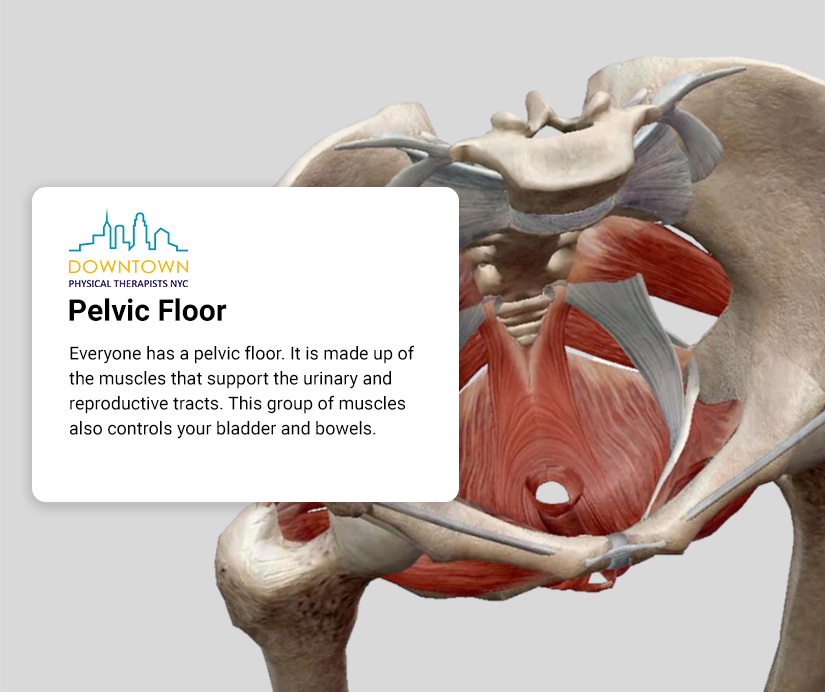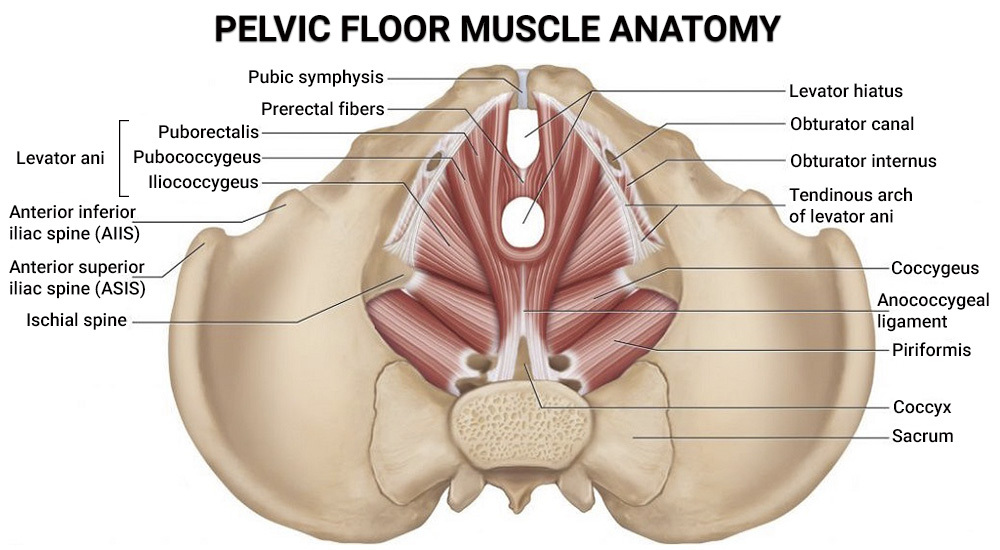If you are experiencing pelvic floor muscle tightness or weakness and the associated problems, pelvic floor physical therapy can help with muscle strengthening, relaxing, and coordination. Pelvic floor physical therapy may be a part of a comprehensive strategy that supports and controls normal functioning of pelvic organs, normal urination, bowel movements, and sexual function. The experienced and board-certified therapists and physicians at the Physical Therapists NYC take a collaborative and holistic approach to successfully treating patients with pelvic floor conditions. With their expertise and knowledge, they create customized treatment plans that fit in with your end goals, strengths, and limitations, and ensure you achieve desired results. The specialized therapy includes exercises that relieve symptoms like pain, discomfort, and disruptions to improve your quality of life.

What Is Pelvic Floor?
Everyone has a pelvic floor. It is made up of the muscles that support the urinary and reproductive tracts. This group of muscles also controls your bladder and bowels.
In women, the pelvic floor keeps the bladder in place, in the front of the vagina, and the rectum in the back. The uterus is held in place at the top of the pelvic floor by muscles, tendons, and connective tissue. In men, the pelvic floor helps the bowels, bladder, urethra, and rectum stay in their place.
The pelvic floor muscles are attached to the tail bone and pubic bone. If the muscles in the pelvic floor are weak or do not work as they should, it can result in a medical condition called pelvic floor dysfunction. It is the inability to appropriately relax and coordinate your pelvic floor muscles to have a bowel movement.
What Is Pelvic Floor Physical Therapy?
Pelvic floor physical therapy is the treatment that addresses problems related to the pelvic floor muscles. It uses the principles of physical therapy to provide a structured, effective, and safe reconditioning of these muscles. Pelvic floor muscles support the pelvic organs, assist in bowel and bladder control, and contribute to sexual arousal and orgasm.
The goal of the treatment is to improve the strength and function of pelvic floor muscles and alleviate pain, weakness, and dysfunction in the muscles. A skilled and trained physical therapist accesses the muscles through the rectum or vagina and manipulates them to improve their strength and functioning. The therapist may either stretch the muscles if they are short and contracted or apply resistance to improve strength if they are weak and dysfunctional.
What Is Pelvic Floor Dysfunction?
If you have pelvic floor dysfunction, your pelvic muscles do not relax or work together with the way they should. If these muscles cannot relax and only tighten, you may have:
- Constipation;
- Urge to pee frequently;
- Trouble controlling your bowels or urine, leading to leaks;
- Pain during sex in women;
- Erectile dysfunction in men.
In some cases, experts are not sure what causes pelvic floor dysfunction. Factors that may trigger this condition include:
- Pelvic surgery;
- Aging;
- Pregnancy;
- Being overweight;
- Overuse of the pelvic muscles;
- Injuries to the pelvic area.

Who Needs Pelvic Floor Physical Therapy?
Pelvic floor physical therapy is recommended for people with pelvic floor dysfunction as well as symptoms associated with it. The particular treatment is targeted at the pelvic floor muscles, ligaments, and connective tissues that work together to support the pelvic organs, contribute to sexual arousal and orgasm and assist in bladder and bowel control.
The tissues are attached to the pelvis and sacrum and coordinated to support the urinary and reproductive tract, including the uterus, prostate, bladder, rectum, urethra, and vagina. They offer pelvic stability and promote proper functioning of pelvic organs, such as sexual and voiding function along with posture and breathing. When pelvic muscles fail to perform the right way, it results in pain and symptoms that affect normal functioning and disturb other organs too.
Benefits of Pelvic Floor Therapy?
Men and women who suffer from weakness in pelvic floor muscles or pelvic floor dysfunction can benefit from physical therapy. It is the first-line remedy for many disorders of the pelvic region. Physicians refer a patient for this therapy if pelvic floor dysfunction is suspected to have a neuromuscular cause.
Dysfunction may result from aging, illness, childbirth, surgery, or other conditions and may coexist with other genitourinary problems, such as urinary incontinence, fecal incontinence, bladder-emptying problems, and constipation. Patients are referred for therapy when they have incontinence, chronic pelvic pain, painful intercourse, and difficulty with bowel movements or urination.
When combined with orthopedic rehabilitation, pelvic floor therapy can help with:
- Urinary incontinence, frequency, and urgency;
- Painful urination;
- Bladder and bowel movements;
- Fecal incontinence;
- Painful sex or pain in the genital area;
- Endometriosis;
- Constipation;
- Menopause symptoms;
- Vaginismus;
- Pain in the pelvis, hip, abdomen, thigh, or low back;
- Rectal pain;
- Unexplained pain;
- Endometriosis;
- Postpartum and pregnancy wellness;
- Interstitial cystitis (IC);
- Pregnancy-related pain;
- Testicular pain.
Women may need to see pelvic therapists for treatment of endometriosis or vaginismus, while men may need support for premature ejaculation and painful ejaculation. Pelvic floor exercises lower their risk of vaginal prolapse, prevent or manage bowel and bladder issues, and assist with recovery after childbirth. It also helps men who have undergone prostate surgery to recover swiftly and reduces the risk of rectal prolapse and improves bladder and bowel movements.
How Does Pelvic Floor Physical Therapy Work?
Pelvic floor physical therapy is an effective way to treat many disorders of the pelvic region. It assists men and women suffering from weakness in pelvic floor muscles by strengthening the floor and enhancing bladder and bowel control.
The healthcare professional or physical therapist will begin with taking the history that includes past surgical and medical record, medications, and sexual, gynecological, or obstetric history. A thorough orthopedic examination is performed with close attention to the lumbar spine and hips, gait, and posture. The assessment usually includes evaluation of both internal and external muscles. The patients are asked to stand, walk and sit so that the therapist can detect any existing posture or joint issues affecting the pelvic floor muscles.
The therapist will evaluate your condition and determine whether the therapy is appropriate and come up with the most appropriate customized care plan. The type of therapy recommended depends on the symptoms experienced. For instance, relaxing and lengthening muscle exercises may be necessary to relieve some symptoms while in other cases, strengthening exercises are appropriate.
The eventual treatment plan may include:
- Stretching or strengthening exercises of the legs, trunk, or pelvic muscles;
- Relaxation exercises for shortened pelvic muscles;
- Education in self-management and prevention;
- Coordination exercises;
- Biofeedback for either relaxation or strengthening of pelvic muscles;
- Modalities such as ice, heat, or electrical stimulation.
The physical therapist manipulates the pelvic floor muscles to restore their strength and function. Shortened and contracted muscles are stretched to relax to relieve pelvic floor pain associated with excessive tightening and cramping. Similarly, appropriate techniques are used to strengthen muscles, alleviate contractions associated with overactive bladder, and keep the bladder, rectum, and uterus in their positions. The goal of this therapy is to ease the pain and associated symptoms and restore normal functioning of the pelvic floor muscles.
Which Techniques Are Used in Pelvic Floor Physical Therapy?
Most pelvic floor therapy techniques are hands-on and include both external and internal treatment. External therapy techniques include nerve release, trigger point therapy, deep tissue massage (myofascial release), skin rolling, and joint mobilization.
Internal techniques may involve using specialized instruments or passing a finger through the rectum or vagina to do trigger point therapy. Due to the nature of internal therapy, many people hesitate to go through it and need time to get used to the concept. The therapists are sensitive to the needs of the patients and do not begin with them unless the patients are ready to move forward.
The therapist applies pressure on a specific point or injects anesthesia into trigger points. The injections are administered by a doctor or nurse practitioner and not a physical therapist. It is important to note that physical therapy is not the only treatment for pelvic floor dysfunction. It can be combined with other forms of pain treatment such as muscle relaxing medication and Botox injections to provide relief.
Other techniques used for treating pelvic floor physical therapy include:
Education and awareness
Patients are taught more about their pelvic anatomy and how different elements work alone and together. Awareness of their body parts, how they are connected, and work help them understand the need for pelvic floor physical therapy. They are also made to understand how hygiene and habits affect their symptoms.
Pelvic floor exercises
The healthcare professional guides the patients in contracting and relaxing pelvic floor muscles relative to other muscles. They also learn breathing and timing techniques that make the exercises more effective. The exercises are designed to stretch tight muscles, strengthen weak muscles and boost flexibility.
Manual therapy
A physical therapist uses hands-on massage and stretching to improve blood circulation, mobility and posture to help patients achieve desired relief.
Pelvic floor biofeedback
The biofeedback technique helps to observe how the pelvic floor muscles work. A probe is inserted into a man’s rectum or the woman’s vagina, and the results are displayed on a computer screen. The healthcare provider can monitor the patient’s progress and get them on the road to quick recovery.
Electrical stimulation
Low voltage electrical current can teach patients how to coordinate the contractions of their muscles, helping to reduce pain and muscle spasms. A therapist may perform the treatment in the clinic or provide an electrical stimulation unit that could be used at home.
Vaginal dilators
Women can use tube-shaped plastic devices that enable them to relax their pelvic muscles for easier penetration. The progressively sized tools are typically inserted into the vagina to stretch the tight tissues. Women, who have undergone gynecological cancer treatment, usually find vaginal dilators beneficial for vaginal rehabilitation after their treatment.
Is Pelvic Floor Physical Therapy the Right Treatment Option?
Even though it may sound like something unusual and invasive, pelvic floor therapy is an effective mode of treatment. Patients see a success rate and enjoy an improved quality of life after treatment, but improvement depends on the severity of the condition being addressed.
Treatment of myofascial pelvic pain takes 6-8 sessions of one hour each for a few weeks, but it may require several months in severe cases. You may also need to return for periodic therapy to keep the problems in check.
If you are suffering from pelvic pain and associated symptoms, you should know that this is not normal, and early treatment is significant for complete recovery and long-term health. The longer you experience chronic pain, the more likely your nerve receptions will get sensitized to it. As a result, your body will develop a heightened reaction to pain, making it more severe and very difficult to treat. Consulting a specialist in pelvic floor disorders is crucial if you are experiencing unexplained chronic pelvic pain for timely diagnosis and treatment.
The award-winning therapists and physicians at the physical therapists NYC have specialized training in internal and external pelvic health dysfunction, examinations, and procedures. They have experience identifying and treating dysfunction in the pelvic floor region and associated symptoms. The top-rated therapists determine what type of treatment you require, come up with an efficient recovery plan and help you achieve your fitness goals to make you feel healthier.





